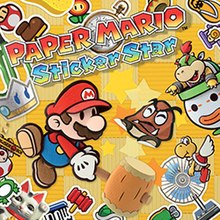| Paper Mario: Sticker Star | |
|---|---|
 North American packaging artwork | |
| Developer(s) | Intelligent Systems |
| Publisher(s) | Nintendo |
| Director(s) | Naohiko Aoyama Taro Kudo |
| Producer(s) | Kensuke Tanabe Toshiyuki Nakamura |
| Designer(s) | Yukio Morimoto Toshitaka Muramatsu |
| Programmer(s) | Junya Kadono |
| Writer(s) | Taro Kudo |
| Composer(s) | List of composers
|
| Series | Paper Mario |
| Platform(s) | Nintendo 3DS |
| Release | |
| Genre(s) | Action-adventure, role-playing |
| Mode(s) | Single-player |
Paper Mario: Sticker Star[a] is a 2012 role-playing video game developed by Intelligent Systems and published by Nintendo for the Nintendo 3DS. Following Super Paper Mario (2007), it is the fourth installment in the Paper Mario series and part of the larger Mario franchise; it is the first game in the series released on a handheld console. In the game, the protagonist Mario and a new ally named Kersti travel across the Mushroom Kingdom to retrieve the six Royal Stickers scattered by Bowser. The game was released in November 2012 in North America and December 2012 overseas.
Unlike the previous Paper Mario games, Sticker Star uses a distinct papercraft visual style, which is heavily incorporated into its gameplay mechanics. Sticker Star introduces stickers, which are littered throughout the game world and serve as single-use items or power-ups, aiding the player in turn-based battles against enemies or in solving puzzles. A sequel for the Wii U, Paper Mario: Color Splash, carried over many ideas introduced in Sticker Star and was released in October 2016.
Game designer and producer Shigeru Miyamoto insisted that gameplay should be distinct from previous Paper Mario games. Because of this, emphasis was geared toward gameplay and combat, with less focus on story. Allies alongside Mario were cut due to complications with sticker mechanics and there was an extreme decrease in characters with unique designs. The game received generally favorable reviews, with graphics, writing, and strategy being praised, and criticism towards unbalanced difficulty in combat, the lack of traditional role-playing game elements, and the abundance of identical Toads instead of the original fictional races the series had been known for. Reception on the sticker mechanics was mixed.
- ^ Fletcher, Leon. "Paper Mario: Sticker Star Dated For Europe". Palm Gamer. Archived from the original on January 31, 2013. Retrieved October 4, 2012.
- ^ "Paper Mario: Sticker Star, White 3DS XL and other 3DS goodies dated". vooks.net. October 22, 2012. Archived from the original on October 24, 2012. Retrieved January 5, 2013.
Cite error: There are <ref group=lower-alpha> tags or {{efn}} templates on this page, but the references will not show without a {{reflist|group=lower-alpha}} template or {{notelist}} template (see the help page).